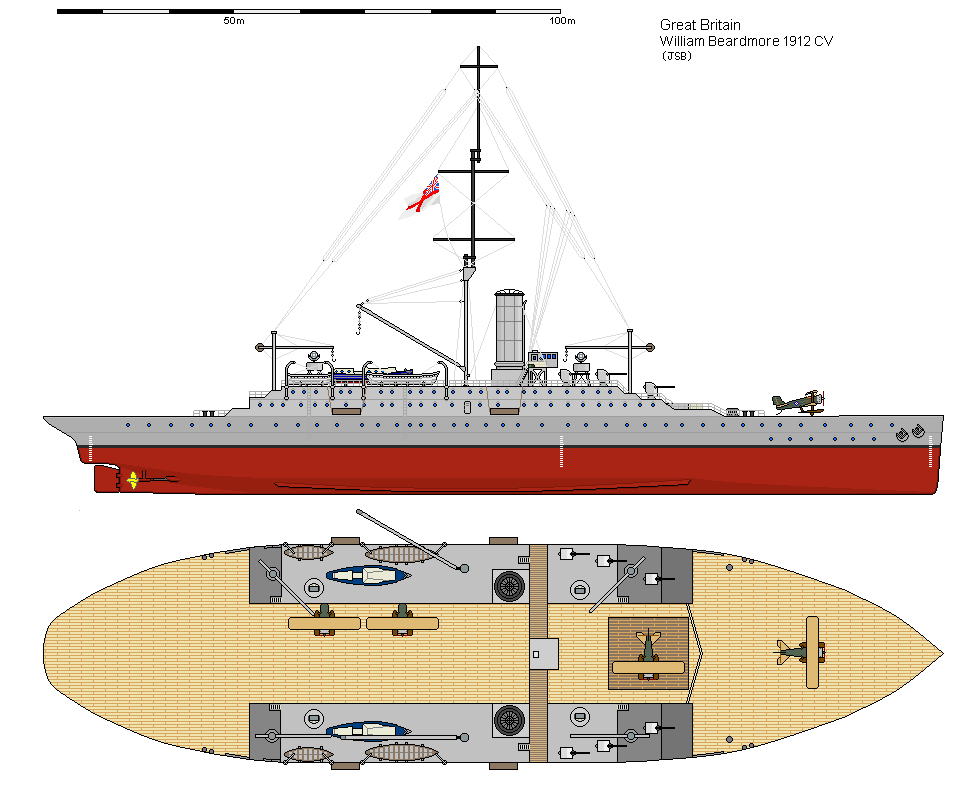I was also thinking as to what lighter units should be built.
The first things that hit me are what not to build. Among those are:
-The K(alamity) Class steam powered fleet submarines. They were designed to make a top speed of 24.5kn surfaced in order to operate with the Queen Elizabeths, which was impossible with the diesels of the time, so they were given steam turbine powerplants for when they were surfaced, plus batteries and a diesel generator for underwater work. Even Jackie "A VERY GREAT INCREASE IN SPEED" Fisher stated that there could be nothing more foolish than a steam-powered submarine. A third of the class was lost, all through accidents and none by enemy action. For the inherent risks of a submarine that had the size of a destroyer, the speed of a (n armoured) cruiser and the turning radius of a battlecruiser, see the "Battle" of May Island, where several were lost to collisions while sailing as a squadron.
-The M-Class submarine cruisers aren't really necessary either, as cool as they are.
-Too many too-small scout cruisers and destroyer flottilla leaders that are too wet.
-Pressing the odds-and-sods foreign dreadnoughts, many with guns that are too small and can't fit directors are probably less useful than just completing the Dream Fleet faster. The pre-Dreads, although outclassed, can just be run into the ground because they're already there.
Now, for what to build:
- An earlier (1913-14) Hawkins class of first-class cruisers. Are they perfect Washington heavies? No, but they're better than any of the old armoured cruisers. The unified battery of 7.5" guns is easier to spot for.
-Stretched (to about 500-525' LOA) C and D class scout/light/2nd-class cruisers with longer, higher bows. Earlier would be nice too.
-Earlier and more V and W class destroyers. Perhaps if Thoryncroft is able to trial their more powerful destroyers a flottilla or two earlier, more of these could be available.
-Make sure most of the subs are E class boats. I can understand why the K and M class boats were built, but starting with one, two tops, prototypes would have been a better way to go.
The first things that hit me are what not to build. Among those are:
-The K(alamity) Class steam powered fleet submarines. They were designed to make a top speed of 24.5kn surfaced in order to operate with the Queen Elizabeths, which was impossible with the diesels of the time, so they were given steam turbine powerplants for when they were surfaced, plus batteries and a diesel generator for underwater work. Even Jackie "A VERY GREAT INCREASE IN SPEED" Fisher stated that there could be nothing more foolish than a steam-powered submarine. A third of the class was lost, all through accidents and none by enemy action. For the inherent risks of a submarine that had the size of a destroyer, the speed of a (n armoured) cruiser and the turning radius of a battlecruiser, see the "Battle" of May Island, where several were lost to collisions while sailing as a squadron.
-The M-Class submarine cruisers aren't really necessary either, as cool as they are.
-Too many too-small scout cruisers and destroyer flottilla leaders that are too wet.
-Pressing the odds-and-sods foreign dreadnoughts, many with guns that are too small and can't fit directors are probably less useful than just completing the Dream Fleet faster. The pre-Dreads, although outclassed, can just be run into the ground because they're already there.
Now, for what to build:
- An earlier (1913-14) Hawkins class of first-class cruisers. Are they perfect Washington heavies? No, but they're better than any of the old armoured cruisers. The unified battery of 7.5" guns is easier to spot for.
-Stretched (to about 500-525' LOA) C and D class scout/light/2nd-class cruisers with longer, higher bows. Earlier would be nice too.
-Earlier and more V and W class destroyers. Perhaps if Thoryncroft is able to trial their more powerful destroyers a flottilla or two earlier, more of these could be available.
-Make sure most of the subs are E class boats. I can understand why the K and M class boats were built, but starting with one, two tops, prototypes would have been a better way to go.
Last edited:
